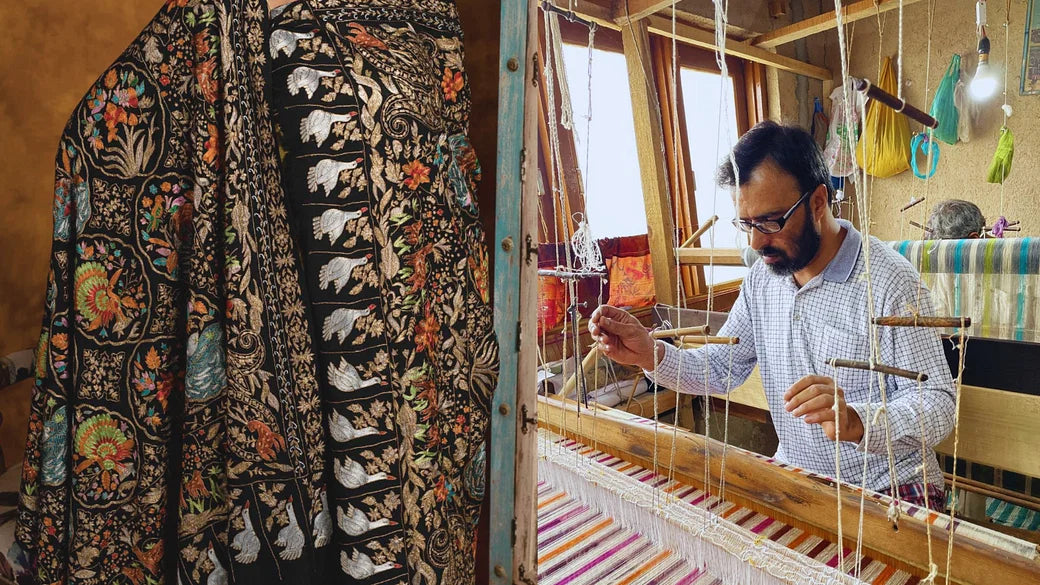
Behind the Scenes: Who Makes Pashmina Shawls?
Share
Introduction
Pashmina, a luxurious and exquisite fabric, has captured the hearts of fashion enthusiasts worldwide. Its softness, warmth, and timeless elegance make it a prized possession for those who appreciate fine craftsmanship. But have you ever wondered who makes these beautiful pashmina shawls? In this blog, we will take you on a journey behind the scenes to discover the artisans, their skills, and the rich cultural heritage that goes into creating these masterpieces.
The Origins of Pashmina
The Treasure of Kashmir
Pashmina shawls find their roots in the enchanting land of Kashmir, India. Kashmir, often referred to as "Paradise on Earth," is not only known for its breathtaking landscapes but also for its rich textile heritage. The word "pashmina" itself is derived from the Persian word "pashm," which means wool. These shawls are made from the soft and warm fleece of the Himalayan mountain goat, locally known as the "Changthangi" or "Pashmina" goat.
Traditional Craftsmanship
The Artisans
The creation of pashmina shawls involves a labor-intensive and highly skilled process that has been passed down through generations. Artisans, primarily from Kashmir, are the backbone of this industry. These skilled craftsmen and women are responsible for transforming raw pashmina wool into the luxurious shawls we adore.
The Materials
Before delving into the process of making pashmina shawls, it's essential to understand the materials involved. The primary material is, of course, the pashmina wool sourced from the Changthangi goats. These goats are found in the high-altitude regions of the Himalayas and produce a wool that is incredibly soft and warm, making it ideal for shawls and scarves. The fine quality of pashmina wool is a result of the harsh climate and unique diet of these goats.
The Pashmina Shawl Making Process
Step 1 - Shearing
Collecting the Precious Wool
The journey of a pashmina shawl begins with the shearing of the Changthangi goats. This process usually takes place in the spring when the goats naturally shed their winter fleece. The collected wool is meticulously cleaned and sorted to separate the fine pashmina fibers from the coarser outer fibers.
Step 2 - Spinning
Creating the Fine Yarn
Once the pashmina wool is separated, it is hand-spun by skilled artisans into fine yarn. This step is crucial in achieving the softness and quality that pashmina shawls are renowned for. The spinning process requires precision and patience, as the yarn must be incredibly thin and delicate.
Step 3 - Dyeing
Adding Vibrant Colors
Pashmina shawls are known for their exquisite colors, often featuring intricate patterns and designs. Natural dyes are commonly used to achieve a wide range of hues, from rich earthy tones to vibrant jewel colors. Artisans carefully mix and apply these dyes to the yarn, creating the desired color palette.
also read: a detailed blog on can you dye pashmina
Step 4 - Weaving
The Loom and Expertise
The weaving of pashmina shawls is a highly specialized skill that requires years of training and experience. Artisans use traditional wooden looms to meticulously craft each shawl. The process is slow and deliberate, as the delicate yarn must be handled with care to avoid damage.
Step 5 - Embroidery (Optional)
Adding Intricate Details
Some pashmina shawls are adorned with intricate embroidery, adding an extra layer of beauty and sophistication. Skilled embroiderers use traditional techniques to create intricate patterns and motifs, often inspired by nature and Kashmiri culture.
also read: a detailed blog on the beauty and craftmanship of kani pashmina a masterpiece of weaving
The Artistry and Cultural Significance
The Symbol of Kashmiri Culture
Pashmina shawls hold a special place in Kashmiri culture. They are not just pieces of clothing; they are works of art that represent centuries of tradition and craftsmanship. These shawls are often given as gifts on special occasions and are considered a symbol of prestige and status.
Preserving a Tradition
Challenges and Conservation
While the demand for pashmina shawls continues to grow, the traditional craft faces several challenges. Climate change, the difficulty of herding the Changthangi goats, and the migration of young artisans to other professions are just a few of the hurdles that threaten this ancient tradition. Efforts are underway to preserve both the goats and the artistry of pashmina making.
Conclusion
In the world of fashion, pashmina shawls stand out as a testament to the beauty of traditional craftsmanship. From the remote Himalayan mountains to the skilled artisans of Kashmir, the journey behind each pashmina shawl is a story of dedication, skill, and cultural heritage. As consumers, it's essential to appreciate the artistry and history behind these luxurious garments and support the efforts to sustain this ancient craft for generations to come.
Whether you wear a pashmina shawl for its warmth, elegance, or cultural significance, it carries with it the rich tapestry of its creation—an art form that continues to thrive amidst the challenges of modern times.
PASHWRAP invites you to explore our exquisite collection of handcrafted pashmina shawls, each a testament to the artistry and heritage of Kashmiri craftsmanship. Join us in preserving this timeless tradition and celebrating the beauty of pashmina




